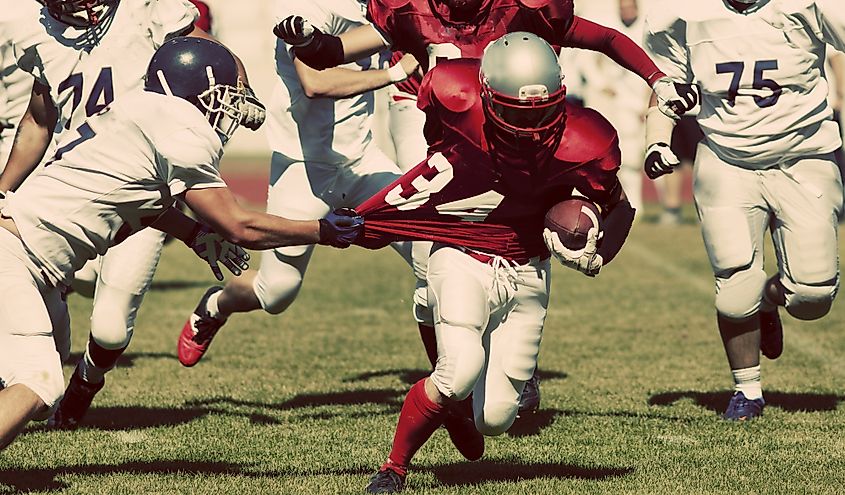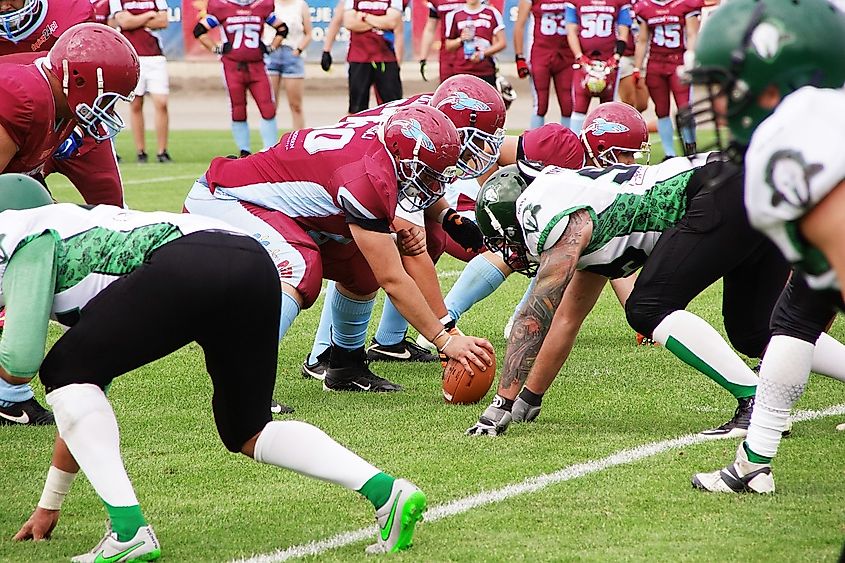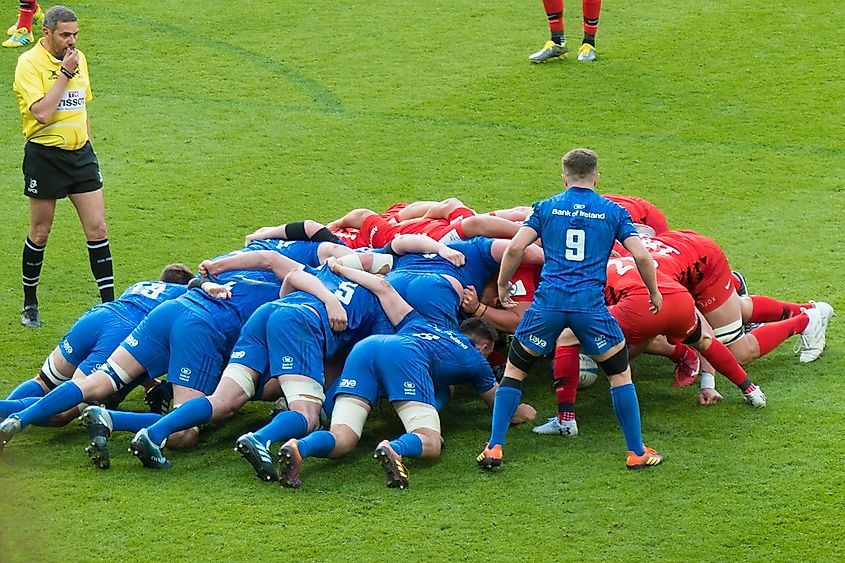10 Main Ways Soccer, American Football and Rugby Differ

- Rugby is the most brutal and dangerous of all three sports
- The scoring systems of Football and Rugby are very similar
- Rugby players use the least amount of equipment between all three sports
- Substitutions in Rugby are only available upon serious injuries
Different cultures have variant notions when it comes to the word "football". The most prevalent and celebrated sport associated worldwide with this word is Soccer due to its legion of fans, history, and simplicity. Fifa is one of the most anticipated global events occurring quadrennially for decades. Americans, on the other hand, have their version of the game with millions of ardent fans spread out across the U.S. The Super Bowl is the second-largest day for U.S. food consumption where tradition dictates drinking beer with family and friends whilst watching the players compete for the ultimate title. Finally, the Land Down Under (Australians) takes contact sport to a whole new level which might be the most brutal of the three. Here are 10 major distinctions between these sports.
Fields Of Green

These games all seem to have one common denominator: location. The fields are covered with green grass that helps cushion the blow for falling players to minimize injuries. With that being said, soccer fields are rectangular shaped and can vary between 65 and 80 yards wide and between 110 and 120 yards long. There is a white circle to mark the center of the field where every match starts, a white rectangle to mark the borders of play, 4 quarter circles on each corner to mark where corner kicks should be executed from, and 2 "penalty boxes" surrounding each goal which is a netted rectangular cube.
American football fields share similarities with soccer in length since the standard dimension is 120 yards, but varies in width with almost 54 yards (53 1/3). Straight white lines are marked every 10 yards to make a full 100, the remaining 20 are considered to be the scoring area, football goalposts are usually 30 feet high "tuning forks" that are used to score extra points by kicking the ball inside them.
Rugby fields are by far the largest of the three, with 122-133 yards long and 74 yards wide dimensions. The field is marked like a football field but instead of 10-yard lines, it uses 10-meter lines, and instead of the "tuning fork", Rugby uses an H shaped goal post that reaches over 60 feet in height.
Rules And Regulations

Soccer rules are rigid when it comes to handling the ball. 11 players on each team battle to score the most goals. Only goalkeepers are allowed to hold the ball as long as they are confined in the borders of the penalty box. All other team members are obliged to use their feet and heads to control the ball in an attempt to shoot it in the opposition's rectangular goal. Tackling in Soccer is only permissible if the tackle is aimed at the ball. It is disadvantageous to tackle an opposing player which could result in the loss of the eleventh player until the end of the match.
Football, however, is also composed of 11 players that are allowed to hold the ball in their hands to try to reach the other end of the field and score a touchdown which is counted as long as the ball crosses the end line in a player's hands. Each play has a limit of 5 downs before conversion; the offensive team can be halted 5 times before handing possession of the ball to the opposition. Tackling is a critical part of the game. It is highly encouraged as a way of getting an upper hand. That's not to say that dangerous tackles wouldn't cost the team a penalty where they usually lose ground.
Finally, Rugby is played with either 15 or 7 players on each team. It uses the same rules as Football when it comes to ball handling and tackles with a major difference in one very crucial detail: passes are only allowed to be made as long as the receiving player is behind the one passing the ball which gives a new meaning to the word "challenge", a player is also allowed to kick the ball and teams usually use this ability to remove an impending threat to their goal line.
Foul Play And Penalties

This is where things get tricky. Each sport has a litany of rules specifically formulated to protect the players' health. Soccer's fouls are usually penalized by a freekick, a penalty shot, a warning (yellow card), or expulsion (red card). Another foul play in Soccer is offside passing where the dribbler passes the ball to a teammate that crossed the last defender of the opposing team which results in conversion and the team loses possession. Foul play in
Football usually results in loss of yards against the defending team or losing a first down if the tackling team is the offense, and in extreme cases might lead to suspensions.
Rugby fouls are usually penalized by a penalty kick, although in some cases the team has the choice between a kick, a run, or a scrum.
Instant Replay
Instant replay is the act of double-checking the initial referee's judgment on a close call of an obscured play. In Soccer, there is no such thing. The referee is the one who has the last call.
Contrarily, American Football and Rugby use this technology to keep the playing fields as fair as possible, since many touchdowns and tries are tough to spot given the draconian rules. The NFL was one of the first pioneers to use such technology in 1986 to ensure correct calls are always made, minimizing the room for error. Rugby was next in the 1996 Super League.
SCORE!

The point system used in Soccer is as simple as can be; one goal equals one point.
Football players can score in two different ways. One way of accomplishing this is by taking the ball to the end of the field and scoring a touchdown for 6 points followed by a field goal that nets a point if successfully kicked. Another tactic is kicking the ball through the goal post and receiving 3 points.
Rugby uses almost the same rules as Football but scoring a try (touchdown) awards 5 points and the field kicks are worth 2 while the dropkick goals are worth 3 points.
Substitutions
Substitutions are vital in every sport whether a team member gets injured or is not in his zone. The coach is required to change tactics, or give a player some rest. Soccer has strict rules when it comes to alternating players mid-game since the coach can change players three times per game. Once an athlete hits the bench, he is not allowed to participate in the match anymore.
Football affords more freedom for the coach to switch any player for an unlimited amount of times whenever he wishes. Most football teams have two different groups of players; one for offense and others for defense.
Rugby is simple in its substitution rules: there are no permanent substitutions unless the injured player does not return to the game in 15 minutes. So unless a team member gets injured there won't be any team changes which is unlikely given the nature of the game.
Balls Of Fury
Perhaps the most apparent difference between the three sports is the balls used. Soccer is played with a round, 8.7-inch diameter ball.
Football balls are 12 inch long prolate spheroids that weigh around 15 ounces, the first footballs were made from inflated pig's bladder which originally gave it its shape and size.
Moving on to Rugby where players use an oval ball that weighs around 14 ounces and is also 12 inches in length. The main difference between both Rugby and Football balls is the narrower end of the latter which facilitates throwing it for pass plays.
Victory Equipment
When it comes to sportswear most sports have a common ground: a jersey, shorts, and boots that show the team's colors to differentiate between the opposing teams. Soccer players have very basic added equipment, they only wear shin pads under their socks to protect their most sensitive leg bone.
Football players have it all! They wear helmets, shoulder pads, gloves, and girdles that have pockets to insert protective pads designed to absorb shocks between the knees and the waistline.
Although Rugby has almost the same aggressive nature as a contact sport, Rugby players are only equipped with a protective groin cup and a mouthguard which leads to many injuries during games.
Time Limit And Game Length

In soccer, the time rules are pretty basic and simple without any complications. The game is played in two 45 minute halves with a 15-minute halftime break where players rest and coaches attempt to improve tactics to ensure victory. Throughout a game of soccer, the clock never stops for any reason, wether it being an injured player, a fan running through the field, or even when the ball goes out of bounds. The referee, however, is bound to add any time lost during the game to the end of the half in which the time was lost, that extra time is referred to as "injury time" and can reach up to 23 minutes! This number was reached in a match where serious injuries occurred throughout the first half that led to an ambulance extracting the injured player so technically there are no limits to the injury time added as long as the entire play length reaches 90 minutes.
Moving on to "American football", a game is split into 15 minute quarters with an equal length half-time break, unless it's the Superbowl where the break is extended significantly to accommodate all the half-time entertainment usually present during the nation-wide event. The clock halts whenever the ball is not in play, meaning if it goes out of bounds, a touchdown is scored, an injury occurs, or the coach calls a time-out. Speaking of which, time-outs are another difference in this contact sport, where coaches are given 5 minutes to change tactics and plays to adapt to the opposition, every team is allowed to call 3 time-outs per game so if both teams take advantage of them all, a game can last a good half-hour more than the usual hour of play.
Last but not least, a Rugby game has 40-minute halves with a 10-minute half-time break that the coach uses to adjust tactics. Just like Soccer, Rugby uses injury time added at the end of each half to make up for lost time with the longest injury time being 20 minutes.
Even Athletes Have Overtime

In most cases, if a game ends in a draw it will be considered as that: a draw. But when it's a playoff game, things get interesting because of overtime. In soccer, starting with the quarter-finals, draws are not tolerated anymore and an extra 2 halves of 15 minutes each are added to the game to declare a winner that will proceed to the semi-finals. If both teams are still at a stalemate after 30 minutes of overtime, they eventually go towards penalty shots to determine the winner; an initial 5 shots are taken and if both teams are still tied, the next team that takes the lead wins the game.
Football is much simpler, both teams will keep playing 10-minute overtime quarters until one of them takes the lead and wins the game.
Rugby's overtime rules dictate that 10-minute halves should be played after the official game time ends; if the score is still a tie after the 20 minutes of overtime both teams enter 10-minute sudden death periods which end as soon as the winning team scores a try.











